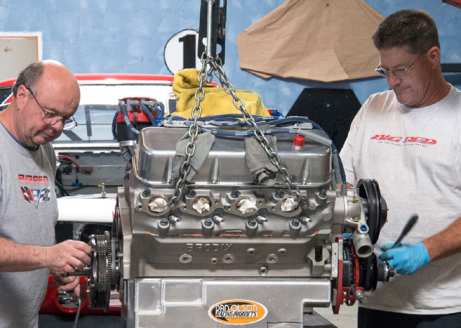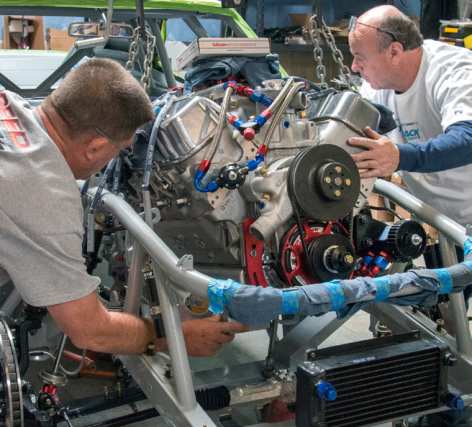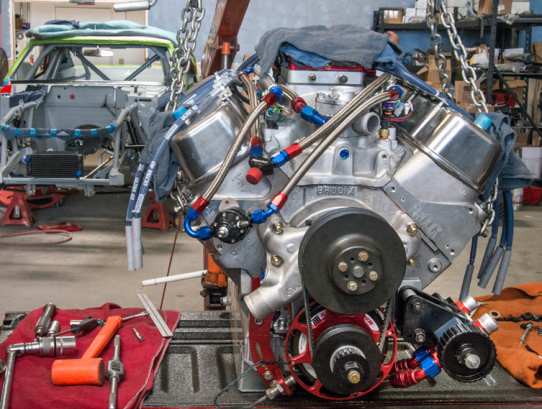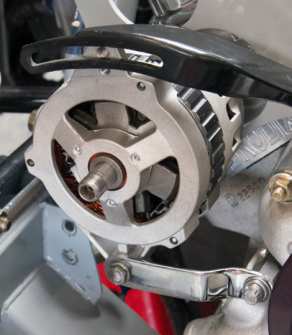Engine Prep

The team has gone through a lot of the major systems to get Big Red ready to receive its 555-cubic-inch big-block Chevy engine. Here are a few details and steps taken to prepare the engine for plumbing and electrical work.
The engines just came back from the dyno shop. Larry went through and readjusted all of the valves. While Larry had the valve cover off, it was an opportunity to photograph the baffle Dave welded to the underside of the valve cover. Oil that’s thrown off the rocker arms tends to go directly into the oil breather fitting in the valve cover, which can fill up in the breather can.
Larry adjusted the valves and set the timing. From this point, the distributor won’t have to be physically moved again, so Larry spread Ultra Black RTV sealant around the base of the distributor. Any future timing adjustments will be done through the Holley Dominator EFI system. Tim aligned the clutch and installed the clutch plates, while Mark finished installing the dry-sump oil pump.
The small Tilton flywheel is installed. It only weighs 4.7 pounds! A stock flywheel can weigh as much as 31 lbs. The lighter rotating mass gives quicker throttle response. Coupled with the 7.25-inch Tilton three-plate metallic racing clutch, the car can decelerate faster upon entering a corner and
accelerate faster out of the corners. This setup will be great at Pikes Peak and on the road course.
Dave needed to add a water temperature sensor to the coolant bypass hose assembly in the back of the intake manifold. He cut
one leg off a -8 AN T-fitting and welded on a threaded bung. He had to do the same for the front bypass hose on the other side of the intake manifold, too. The bypass hoses allow air in the back of the engine to push to the front of the intake. This helps the back of the cylinder heads flow and run cooler.
Last-minute checks are done on the engine prior to installation. The tailgate is a good height to work on the engine, but it couldn’t hold the engine safely, so they left it on the hoist.
Two Beast 555 engines. Over 900 rear-wheel horsepower, times two! The one on


the engine hoist is going to be installed. The one on the dolly is the backup engine, and is an exact copy. The backup engine is a fully prepped long block: water pump, dry-sump oil pump, distributor, etc. The spare has all the ports and openings sealed closed. It will be in the trailer every time they go to a road race or hill-climb event. The device with chains, between the cherry picker and the engine, is called an “engine tilter.” In the position seen here, its handle can be cranked different directions to tilt/rotate side to side for ease of installation. It also can be mounted front to back to help tilt the transmission up and down.
The guys are installing the engine and transmission as a single unit. Overall, installing the engine is much easier with the new clearance on the firewall and around the bellhousing. Mark and Tim align everything up front, while Dave is in the car guiding the transmission through the removable transmission tunnel.
The engine block is bolted to the chassis using the conventional engine mount locations on the sides of the block, as well as custom motor plates (not shown)
mounted on the heads. Mark mounted the Powermaster Motorsports CS130 alternator on a set of alternator brackets custom built by Dave. The alternator received a large, five-inch-diameter pulley to reduce its speed at high rpm while running Pikes Peak.
They installed the Tilton starter in the bellhousing and then connected the cables. The positive wire is coming directly from the solenoid on the firewall. To protect the positive cable from heat coming from the headers, they wrapped it with DEI sleeve.The Intake Air Temperature (IAT) sensor had to be added to
the air cleaner, so Dave TIG-welded a bung to the aluminum air-cleaner base.
Tim added K&N air filter oil to the new K&N air filter and X-Stream top. The oil is what helps trap dirt and debris in the cotton fabric in the filter element.
